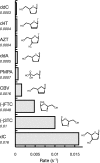Exonuclease removal of dideoxycytidine (zalcitabine) by the human mitochondrial DNA polymerase
- PMID: 17984232
- PMCID: PMC2223897
- DOI: 10.1128/AAC.00778-07
Exonuclease removal of dideoxycytidine (zalcitabine) by the human mitochondrial DNA polymerase
Abstract
The toxicity of nucleoside analogs used for the treatment of human immunodeficiency virus infection is due primarily to the inhibition of replication of the mitochondrial genome by the human mitochondrial DNA polymerase (Pol gamma). The severity of clinically observed toxicity correlates with the kinetics of incorporation versus excision of each analog as quantified by a toxicity index, spanning over six orders of magnitude. Here we show that the rate of excision of dideoxycytidine (zalcitabine; ddC) was reduced fourfold (giving a half-life of approximately 2.4 h) by the addition of a physiological concentration of deoxynucleoside triphosphates (dNTPs) due to the formation of a tight ternary enzyme-DNA-dNTP complex at the polymerase site. In addition, we provide a more accurate measurement of the rate of excision and show that the low rate of removal of ddCMP results from both the unfavorable transfer of the primer strand from the polymerase to the exonuclease site and the inefficient binding and/or hydrolysis at the exonuclease site. The analogs ddC, stavudine, and ddATP (a metabolite of didanosine) each bind more tightly at the polymerase site during incorporation than normal nucleotides, and this tight binding contributes to slower excision by the proofreading exonuclease, leading to increased toxicity toward mitochondrial DNA.
Figures




Similar articles
-
Insights into the molecular mechanism of mitochondrial toxicity by AIDS drugs.J Biol Chem. 2001 Jun 29;276(26):23832-7. doi: 10.1074/jbc.M101156200. Epub 2001 Apr 27. J Biol Chem. 2001. PMID: 11328813
-
Differential incorporation and removal of antiviral deoxynucleotides by human DNA polymerase gamma.J Biol Chem. 2001 Jun 29;276(26):23616-23. doi: 10.1074/jbc.M101114200. Epub 2001 Apr 23. J Biol Chem. 2001. PMID: 11319228
-
Structural determinants in human DNA polymerase gamma account for mitochondrial toxicity from nucleoside analogs.J Mol Biol. 2003 May 23;329(1):45-57. doi: 10.1016/s0022-2836(03)00405-4. J Mol Biol. 2003. PMID: 12742017
-
Perspectives on the molecular mechanism of inhibition and toxicity of nucleoside analogs that target HIV-1 reverse transcriptase.Biochim Biophys Acta. 2002 Jul 18;1587(2-3):296-9. doi: 10.1016/s0925-4439(02)00092-3. Biochim Biophys Acta. 2002. PMID: 12084471 Review.
-
Toxicity of nucleoside analogues used to treat AIDS and the selectivity of the mitochondrial DNA polymerase.Biochemistry. 2003 Dec 23;42(50):14711-9. doi: 10.1021/bi035596s. Biochemistry. 2003. PMID: 14674745 Free PMC article. Review.
Cited by
-
Mitochondrial DNA replication: a PrimPol perspective.Biochem Soc Trans. 2017 Apr 15;45(2):513-529. doi: 10.1042/BST20160162. Biochem Soc Trans. 2017. PMID: 28408491 Free PMC article. Review.
-
A transient kinetic approach to investigate nucleoside inhibitors of mitochondrial DNA polymerase gamma.Methods. 2010 Aug;51(4):392-8. doi: 10.1016/j.ymeth.2010.05.001. Epub 2010 May 31. Methods. 2010. PMID: 20573564 Free PMC article. Review.
-
The antiretroviral 2',3'-dideoxycytidine causes mitochondrial dysfunction in proliferating and differentiated HepaRG human cell cultures.J Biol Chem. 2021 Jan-Jun;296:100206. doi: 10.1074/jbc.RA120.014885. Epub 2020 Dec 31. J Biol Chem. 2021. PMID: 33334881 Free PMC article.
-
Balancing antiviral potency and host toxicity: identifying a nucleotide inhibitor with an optimal kinetic phenotype for HIV-1 reverse transcriptase.Mol Pharmacol. 2012 Jul;82(1):125-33. doi: 10.1124/mol.112.078758. Epub 2012 Apr 18. Mol Pharmacol. 2012. PMID: 22513406 Free PMC article.
-
Boron-containing nucleosides as tools for boron-neutron capture therapy.Am J Cancer Res. 2021 Oct 15;11(10):4668-4682. eCollection 2021. Am J Cancer Res. 2021. PMID: 34765286 Free PMC article. Review.
References
-
- Adkins, J. C., D. H. Peters, and D. Faulds. 1997. Zalcitabine. An update of its pharmacodynamic and pharmacokinetic properties and clinical efficacy in the management of HIV infection. Drugs 53:1054-1080. - PubMed
-
- Cammack, N., P. Rouse, C. L. Marr, P. J. Reid, R. E. Boehme, J. A. Coates, C. R. Penn, and J. M. Cameron. 1992. Cellular metabolism of (−) enantiomeric 2′-deoxy-3′-thiacytidine. Biochem. Pharmacol. 43:2059-2064. - PubMed
-
- Chang, C. N., S. L. Doong, J. H. Zhou, J. W. Beach, L. S. Jeong, C. K. Chu, C. H. Tsai, Y. C. Cheng, D. Liotta, and R. Schinazi. 1992. Deoxycytidine deaminase-resistant stereoisomer is the active form of (+/−)-2′,3′-dideoxy-3′-thiacytidine in the inhibition of hepatitis B virus replication. J. Biol. Chem. 267:13938-13942. - PubMed
-
- Chang, C. N., V. Skalski, J. H. Zhou, and Y. C. Cheng. 1992. Biochemical pharmacology of (+)- and (−)-2′,3′-dideoxy-3′-thiacytidine as anti-hepatitis B virus agents. J. Biol. Chem. 267:22414-22420. - PubMed
-
- Donlin, M. J., S. S. Patel, and K. A. Johnson. 1991. Kinetic partitioning between the exonuclease and polymerase sites in DNA error correction. Biochemistry 30:538-546. - PubMed
Publication types
MeSH terms
Substances
Grants and funding
LinkOut - more resources
Full Text Sources
Medical

